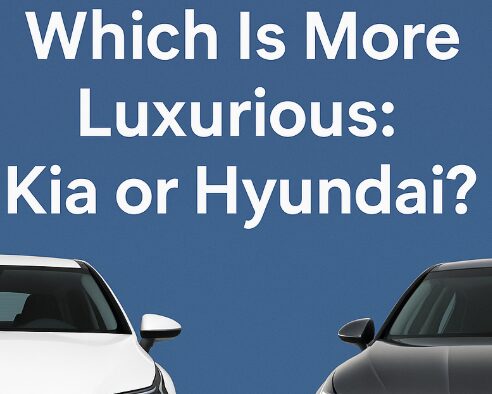South Korean car brands have come a long way from being budget options in the global automotive market. Over the past two decades, both Kia and Hyundai have transformed their lineups, offering vehicles that now rival traditional luxury manufacturers in design, technology, and performance. But for international car buyers, one question often arises: Which brand is more luxurious — Kia or Hyundai?
In this post, we’ll explore how Kia and Hyundai compare in terms of luxury, brand positioning, and model offerings. We’ll also take a closer look at where their cars are actually made, and how their global manufacturing footprint affects quality and availability for international buyers.
This guide is written for global readers — especially those interested in buying a South Korean vehicle or simply curious about the evolution of these two major brands.

Understanding the Relationship Between Kia and Hyundai
Before diving into which brand is more luxurious, it’s important to understand that Hyundai Motor Group owns Kia. They operate independently in terms of branding, design teams, and marketing strategies, but they often share platforms, powertrains, and R&D costs.
This means that under the hood, many Kia and Hyundai vehicles have similar engines and transmissions. But when it comes to design language, target audience, and driving feel, the two brands deliberately differentiate themselves.
Which Brand Is More Luxurious?
Both Kia and Hyundai have made substantial efforts to introduce luxury-oriented vehicles — but Hyundai has the edge due to its dedicated luxury division, while Kia leans more toward premium value.
Hyundai’s Luxury Identity: Genesis
Hyundai launched Genesis as its standalone luxury brand in 2015, much like how Toyota has Lexus or Nissan has Infiniti. Genesis models — like the G80, G90, and GV80 SUV — are designed to compete with BMW, Audi, Mercedes-Benz, and Lexus.
Genesis cars feature:
Premium materials and finishes
Advanced driver-assistance features
Quiet and refined cabins
Rear-wheel drive platforms
Concierge-level customer service in some markets
Because Genesis is a Hyundai sub-brand, Hyundai itself doesn’t need to push its core vehicles into the luxury segment — it can focus on near-luxury and comfort-oriented mainstream models like the Palisade, Sonata, and Santa Fe.
Kia’s Upscale Push: GT-Line and EV6/EV9
Kia, on the other hand, doesn’t have a separate luxury brand, but that doesn’t mean it’s not moving upmarket. Models like the Kia K9 (also known as the K900), Stinger GT, and EV9 show Kia’s ambition to blend performance, tech, and premium finishes into its top models.
What defines Kia’s luxury approach:
Sportier, more aggressive design
Value-packed features at lower price points
A driver-focused experience (especially in GT trims)
Cutting-edge EV technology (EV6, EV9)
Kia’s vehicles often look more youthful and dynamic, appealing to a different audience than Hyundai.
Comparison by Segment
Let’s break it down by car type:
| Segment | Hyundai Example | Kia Example | Luxury Edge |
|---|---|---|---|
| Full-size SUV | Hyundai Palisade | Kia Telluride | Even (shared platform) |
| Electric Vehicle | Hyundai IONIQ 6 | Kia EV6, EV9 | Kia (design + GT trims) |
| Sedan | Hyundai Sonata | Kia K5 | Even (styling preference) |
| Performance Sedan | Genesis G80 | Kia Stinger GT | Genesis (luxury) |
| Flagship Luxury | Genesis G90 | Kia K9 / K900 | Genesis |
In short, Hyundai owns the luxury crown, primarily through Genesis, while Kia delivers strong performance and value in the upper-tier mainstream segment.
Interior Quality and Tech: Who Wins?
Both brands now offer cabins with soft-touch materials, digital instrument clusters, and driver assistance features like adaptive cruise control and lane-keeping. However:
Hyundai tends to focus on refinement and comfort, with well-insulated interiors and upscale finishes.
Kia aims for a sportier, driver-centric layout, with bolder styling and sharper interface designs.
In recent reviews, Hyundai’s Palisade has been praised for having a “near-luxury” feel, while Kia’s EV9 has been recognized for luxury-level tech integration at a non-luxury price.
Where Are Kia and Hyundai Cars Made?
Contrary to popular belief, not all Kia and Hyundai vehicles are built in South Korea. Both brands operate a global manufacturing network, enabling them to serve different markets efficiently and reduce production costs.
Hyundai Manufacturing Locations
South Korea: Main production center (Ulsan Plant – one of the largest in the world)
United States: Montgomery, Alabama (Sonata, Santa Fe, Tucson)
Czech Republic: Nosovice plant (for European models)
India: Chennai plant (Venue, Verna, Creta)
Indonesia and Brazil: Regional models
Kia Manufacturing Locations
South Korea: Sohari, Gwangmyeong, Hwaseong (Stinger, Carnival, Sorento)
United States: West Point, Georgia (Kia Telluride, Sorento, Sportage)
Slovakia: Zilina plant (Sportage, Ceed)
Mexico: Nuevo León (Forte/K3, Rio)
India: Andhra Pradesh (Sonet, Seltos)
For buyers in the U.S., many popular models like the Kia Telluride or Hyundai Santa Fe are built domestically, while flagship or luxury models are still imported from Korea.
Reliability and Warranty
Both Hyundai and Kia offer industry-leading warranties:
10-year / 100,000-mile powertrain warranty
5-year / 60,000-mile bumper-to-bumper warranty
Reliability ratings have improved significantly in recent years, with both brands now consistently ranked in the top half of J.D. Power and Consumer Reports lists.
Final Thoughts: Kia vs Hyundai — Which Should You Choose?
If you want a car that delivers refined ride quality, premium materials, and comfort-first design, go with Hyundai — or upgrade to Genesis if you’re seeking full-on luxury.
If you’re after a vehicle that looks bolder, drives sportier, and offers premium features without the badge markup, Kia is an excellent choice.
When it comes to luxury, Hyundai — through Genesis — takes the crown. But if we’re comparing Kia and Hyundai without Genesis, the competition becomes much closer, with Kia often offering more design-forward and value-packed alternatives.
And no matter which you choose, you’ll be driving a car built by one of the most innovative, fast-rising automotive groups in the world, with a global footprint and a reputation that’s only getting stronger.